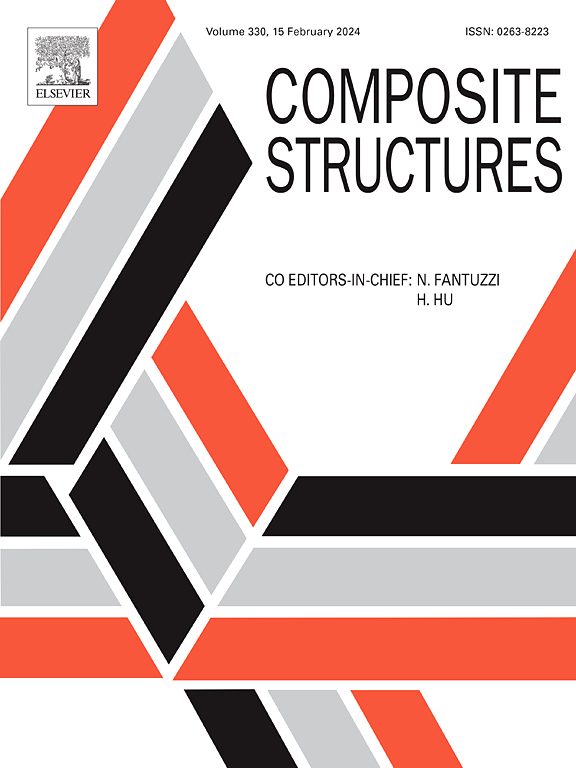Modified friction stir deposition – Additive manufacturing, an approach to fabricate multi-layered AA5083/CeO2/B4C nano-composites with enhanced corrosion and tribological behavior
IF 6.3
2区 材料科学
Q1 MATERIALS SCIENCE, COMPOSITES
引用次数: 0
Abstract
Modified friction stir deposition – additive manufacturing (MFSD-AM), also called friction stir additive manufacturing, was used to fabricate additive aluminum matrix composites (AAMCs) with constant process parameters. MFSD-AM uses consumable tools instead of the unconsumable hollow tool used in conventional methods. The rotating tool withdraws as soon as a specified amount of the consumable is deposited. Layer-by-layer deposition of the consumables produces AAMC. Consumable Al-Mg tools were drilled and different portions of nano-sized cerium oxide and boron carbide reinforcements were sealed in the tools. One reference – additive manufactured product (Ref-AMP) was fabricated without inserting reinforcements to be compared with AAMCs and to observe the effects of embedding reinforcements. This study designates the outcomes of inserting different reinforcement volume ratios on microstructure, hardness, wear performance, and corrosion behavior of the resulting AAMCs. Up to 52.9 % grain refinement was achieved for AAMCs compared to the Ref-AMP. Excellent reinforcement circulation inside AAMCs was assured. Up to 34.7 % increase in hardness was achieved for AAMCs compared to the Ref-AMP. Up to 43.6 % decrease for AAMCs was achieved compared to the specific wear rate of the Ref-AMP. Corrosion resistance increased for AAMCs compared to the Ref-AMP. AAMCs exhibited up to 503 mV passivation ranges.
改良摩擦搅拌沉积--增材制造--一种制造具有更强腐蚀和摩擦学性能的多层 AA5083/CeO2/B4C 纳米复合材料的方法
改良搅拌摩擦沉积-添加式制造(MFSD-AM),又称搅拌摩擦添加式制造,用于制造工艺参数恒定的添加式铝基复合材料(AAMC)。MFSD-AM 使用可消耗的工具,而不是传统方法中使用的不可消耗的空心工具。当指定量的耗材沉积完成后,旋转工具立即退出。耗材的逐层沉积产生 AAMC。可消耗的铝镁工具被钻孔,不同部分的纳米尺寸氧化铈和碳化硼加固材料被密封在工具中。为了与 AAMCs 进行比较,并观察嵌入加固材料的效果,在未嵌入加固材料的情况下制造了一种参考添加剂制造产品 (Ref-AMP)。本研究探讨了插入不同体积比的增强材料对 AAMC 的微观结构、硬度、磨损性能和腐蚀行为的影响。与 Ref-AMP 相比,AAMC 的晶粒细化率高达 52.9%。确保了 AAMC 内部良好的强化循环。与 Ref-AMP 相比,AAMC 的硬度提高了 34.7%。与 Ref-AMP 的特定磨损率相比,AAMCs 的磨损率降低了 43.6%。与 Ref-AMP 相比,AAMCs 的耐腐蚀性增强。AAMCs 的钝化范围高达 503 mV。
本文章由计算机程序翻译,如有差异,请以英文原文为准。
求助全文
约1分钟内获得全文
求助全文
来源期刊

Composite Structures
工程技术-材料科学:复合
CiteScore
12.00
自引率
12.70%
发文量
1246
审稿时长
78 days
期刊介绍:
The past few decades have seen outstanding advances in the use of composite materials in structural applications. There can be little doubt that, within engineering circles, composites have revolutionised traditional design concepts and made possible an unparalleled range of new and exciting possibilities as viable materials for construction. Composite Structures, an International Journal, disseminates knowledge between users, manufacturers, designers and researchers involved in structures or structural components manufactured using composite materials.
The journal publishes papers which contribute to knowledge in the use of composite materials in engineering structures. Papers deal with design, research and development studies, experimental investigations, theoretical analysis and fabrication techniques relevant to the application of composites in load-bearing components for assemblies, ranging from individual components such as plates and shells to complete composite structures.
 求助内容:
求助内容: 应助结果提醒方式:
应助结果提醒方式:


